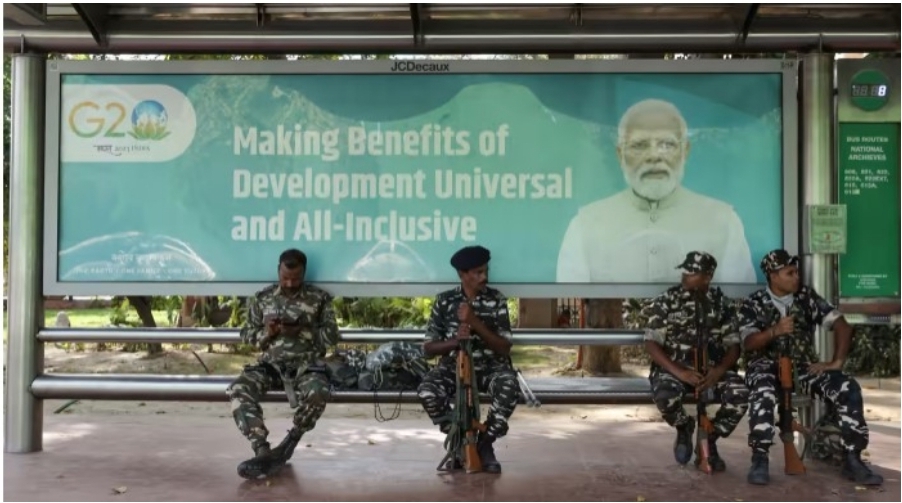By Swaminathan S. Anklesaria Aiyar
New Delhi, September 8 (Nikkei Asia): In the run-up to the Group of 20 summit this weekend in New Delhi, billboards and bus stops in every Indian city are plastered with images of Prime Minister Narendra Modi, who will preside over the gathering of leaders from around the globe.
The posters hail India, via Modi, as a Vishwaguru — a Sanskrit term for world guru or teacher to the world. Similar advertisements have covered the front pages of major newspapers.
India has never seen an advertising blitz of this magnitude. A former finance secretary estimated the cost at 10 billion rupees ($121 million) and rising. He sees the push as the start of Modi’s 2024 reelection campaign.
It is of course convenient to have the government, rather than the ruling Bharatiya Janata Party (BJP), pay for this ad campaign. Indian politicians of all stripes have done similar things in the past, but the scale of the current campaign beggars description.
By law, the most that can be spent on a campaign for a parliamentary seat is 9.5 million rupees. The legal cost to contest all 543 seats in the Lok Sabha would thus be no more than 5 billion rupees.
Critics who think Modi is trying to impress foreign visitors are clearly mistaken. This advertising blitz is aimed at financing the promotion of the prime minister in the election run-up, portraying him as a great leader of not just India but the world.
This message plays well with the Hindu nationalist BJP, whose members believe India was the greatest and richest civilization in the world in ancient times but then enslaved and impoverished by Muslim and British invaders. Modi himself says he has rescued India following centuries of “enslavement.”
In the face of both threats and inducements, the Indian media is not talking much about Modi’s use of government money to advance a personality cult or boost his election prospects. Dissenters of all sorts, whether in business, media or the nonprofit sector, have faced raids for supposed tax or foreign exchange violations that are likely to keep them tied up in court for years.
Indian media companies, meanwhile, are making millions of dollars from running Modi’s advertisements, which they would lose if they played their intended democratic role of speaking truth to power. Very few are willing to pay this price.
Modi’s notion of being the world’s guru is just as ridiculous as his twisted history of “centuries of enslavement,” which has been used to attack India’s religious minorities.
Protesters in Dhaka decry violence against Muslims in India ahead of Prime Minister Narendra Modi’s visit in 2020. © Reuters
A guru is nothing without disciples. If India or Modi himself is the world’s guru, who are the disciples? The least likely candidates are Western powers which believe, rightly or wrongly, that they are the true global gurus.
It might seem that India’s disciples would be most likely to come from its geographic neighborhood rather than distant lands. But even a cursory examination shows otherwise.
Does Pakistan regard India as a guru? No, it is India’s greatest foe. It has allied with China, India’s other major foe, to try and put India in its place. No disciples there.
What about Bangladesh, which India helped to achieve independence from Pakistan in 1971? There is now little gratitude for India’s help, which is accurately viewed as a ploy to split and disempower Pakistan rather than an altruistic move to aid Bangladeshis.
Prime Minister Sheikh Hasina is about the only Bangladeshi politician to express somewhat pro-Indian views, and even she has to step carefully. The Hindu share of Bangladesh’s population has shrunk from 30% at the time of Pakistan’s independence in 1947 to 7.5% today, as many have migrated to India to escape discrimination and persecution. No sign of Indian disciples in Bangladesh.
Sri Lanka? Many there harbor ill will toward New Delhi in the belief that it supported the development of the Tamil Tiger insurgency when Indira Gandhi was India’s prime minister in the early 1980s. The insurgency became a civil war in which up to 100,000 were killed. Hard to find disciples there.
What about Nepal, a predominantly Hindu nation? Ever since then-Indian Prime Minister Jawaharlal Nehru intervened in a royal power struggle in 1951, Nepalese have viewed New Delhi as an imperial power to be feared. India has on more than one occasion blocked essential supplies to Nepal to try to exert political influence. Nepalese may be Hindus, but they are anything but Modi’s disciples.
What about the West? It sees India as a rising economic power to be wooed. Western investment is pouring into India and the West lauds India’s success in digital payments, financial inclusion and social programs.
But some in the West also castigate the Indian government for eroding democratic values and human rights and suppressing civic groups. Freedom House, an American rights group, downgraded India from “free” to “partly free” in its 2021 index of political and civil liberties around the world. Sweden’s V-Dem Institute classifies India as an “electoral autocracy.”
In its annual World Press Freedom Index, Reporters Without Borders ranked India a dismal 161st. In the global Human Freedom Index compiled by the Cato Institute, India fell from 75th place in 2015 to 112th in 2022.
Indian government officials criticize these indexes as flawed. Maybe so, but the notion of India as a Vishwaguru sounds like a bad joke in the West.
India has certainly provided the world with yoga, transcendental meditation and the Bhagavad Gita. Indian mathematicians invented the concept of zero and sundry equations in ancient times. Bollywood has global fans today for its films and music.
This adds up to a reasonable amount of soft power. Alas, it is not the stuff of which world gurus are made.
(Swaminathan S. Anklesaria Aiyar is a research fellow at the Cato Institute, a Washington-based think tank)





